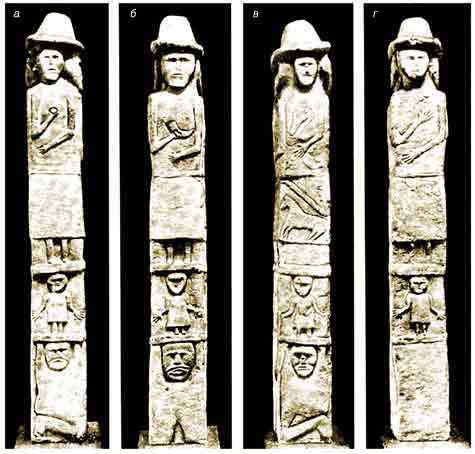See part 1 here
Tuesday is perhaps the most problematic day; while there are a plethora of Slavic war deities, none of them feel like a very good fit for one reason or another. There’s seven-headed Svetivit or Svantovit, a war god of the Polabian Slavs on the isle of Rugen, but he was probably likely a local deity unknown to the greater Slavic world or else possibly a hypostasis of another god like Perun (or maybe even multiple gods, hence the seven heads). There is Jarilo, whose name is derived from a Slavic folk festival, who is sometimes identified as a war god but is on the whole a more Dionysian figure of spring. There’s Chernobog, the “black god,” primarily a figure of personified bad luck, but might be the same as the war and victory god ‘Tjarnaglofi’ mentioned in the Danish Knytlinga Saga (but probably nott). 1see Gorbachov – What Do We Know about *Čьrnobogъ https://brill.com/view/journals/ruhi/44/2-3/article-p209_209.xml Even Dazhbog, as a sky god and ancestral figure, is in some ways equivalent to the Germanic Tiwes, but lacks a martial character in any source.

This leads me to Stribog. Stribog is generally accepted as a god of wind, first and foremost. His only real association with war is an allusion to how the wind carries the arrows of an adversary, which while nothing, is admittedly not strong evidence. Tatischev associated Stribog with the Latin Mars, but never really justified why, and possibly was trying to overfit his model to match other pantheons. In order for me to justify Stribog, I had to dig a bit deeper into the whole process of how the different deities were associated with days of the week. As I mentioned, the whole process started in Mesopotamia, and the deity associated with the planet Mars was Nergal, a god of war but also of death and disease. When it came time for the Greeks to adapt the Babylonian system, there was not generally an exact match between deities in the two cultures, so they had to choose which particular aspects to emphasize. Now, Stribog is not a god of disease or death either, but of all the elements in Russian folklore, the wind seems to be primarily malevolent, spreading disease and misfortune (see Elizabeth Warner’s Russian Myth). This, together with the seeming importance of wind in Slavic mythology (there is possibly another West Slavic deity called Poxvist or Pozvizd, and many fantastic creatures associated with the whirlwind in South Slavic folklore), convinced me to promote Stribog for Tuesday.
There are a couple options for Wednesday… Stribog could be a vague fit, given the connection of wind with Mercury’s fleetness, but it seems a bit of a stretch for me. Svarog, a sky deity and ancestor of some other deities seems to me to have some parallels to the Norse Odin, but he’s elsewhere compared to Hephaestus, and also seems a closer parallel to Uranus. The best fit, then, is Veles or Volos. Veles is one of the deities we know the most about, both from written sources, surviving idols, and his later association with Saint Blaise in Russia. Veles is a chthonic deity, with parallels to Pluto, and as the god of cattle he also became associated with wealth. It is significant that his idol in Kyiv seems to have been located in the merchant’s quarter, and trade was Mercury’s domain as well. Veles also seems to have been associated with magic, which connects him not only to Mercury and Hermes but also Odin and Mesopotamian Nabu.
Thursday goes to Perun. Perun was a thunder god, much like Thor or Jupiter, and like Jupiter or Mesopotamian Marduk he was usually in the role as chief of the pantheon. Like Veles, Perun left a large trace on Slavic customs, often being conflated with Saint Elijah. Finally, in my research I found that Perun was was actually historically associated with Thursday, or Perundan, in the language of the Polabian Slavs! The same can’t be said for any other deities.
The obvious choice for Friday is probably Mokosh. As the patron of moist mother earth, she was a fertility deity like Freyja, Venus, Aphrodite, and Ishtar, and her presence among Vladimir’s idols marks her as an important deity, albeit there is less trace of her than either Perun or Veles. Another runner up might be the Zorya, twin (or triplet) deities associated with the dawn star and the evening star, that is, the planet Venus. I’d go with Mokosh over the Zorya though because, despite their recent popularity thanks to Neil Gaiman’s ‘American Gods,’ we’re not sure to the extent that the Zorya were major deities or more like pseudo-deities, as there aren’t surviving written records of them, only in customs and songs.
To be concluded…